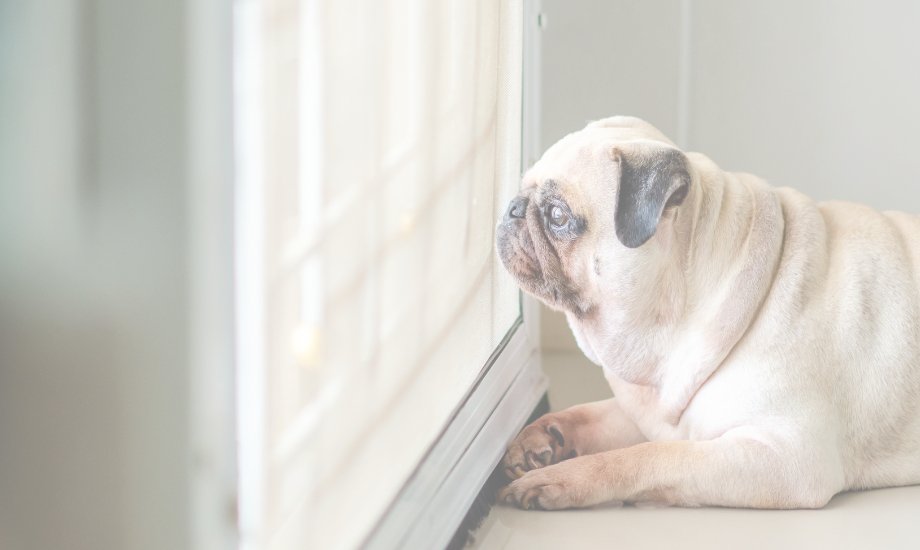Reading time: 3.5 minutes
Does your dog tear the house apart if you leave without them? As frustrating as it is to come home to torn-up pillows or pee on the floor, your pup’s destruction isn’t meant to make you mad – it’s often a sign of separation anxiety.
Some dogs experience separation anxiety when they are apart from their guardians or the people they are most attached to – that’s you! The distress an anxious dog feels is hard to see or hear, of course, and nobody wants to come home to a mess. But separation anxiety can also be harmful for dogs when it causes them to try to escape, which can lead to injuries.
Read on for the signs of separation anxiety in dogs you should watch for, and for easy tips on reducing that anxiety and helping your pup handle – or even enjoy! – their time home alone.
😰 What are signs of separation anxiety?
Every dog is different, so the symptoms of separation anxiety can vary. Some anxious dogs make their stress obvious, while others might not show it until you’ve already left the house.
Here are a few of the most common signs of separation anxiety to watch for:
- Signs of stress, like drooling or trembling, when you are preparing to leave the house or walking out the door.
- Peeing or pooping in the house, when your dog is housetrained.
- Excessive howling or barking, for long periods of time.
- Appearing anxious or depressed when you leave, or are getting ready to leave, the house.
- Trying to prevent you from leaving – for example, by blocking your path.
- Destruction of items or areas of the home due to chewing, scratching, or digging.
- Signs your dog tried to escape or get out of the house, like a broken screen in a door.
- Excessive excitement when you return home, even if you were only away for a short period of time.
🐢 Solve separation anxiety by starting slow
Help your dog get through separation anxiety by leaving the house for short periods of time, then gradually increasing them. This isn’t doable for everyone, of course, but it can help your pup slowly get used to being home without you.
You can pair this approach with rewards – for example, give your pup a high-value treat right before you leave. Choose something special with a great smell, like healthybud’s Duck Calming Aid, to get their attention. The excitement of the treat might distract them from the fact you’re leaving!
🐶 Make leaving low-key
It’s better to downplay the fact that you’re leaving – if you head out as if it’s not a big deal, you avoid signaling to your dog that it is a big deal! Avoid saying goodbye if it ramps up your pup’s anxiety, or say goodbye affectionately but quickly. Either way, be calm and positive as you head out the door.
🚶🏾 Work in exercise
Make time before you leave the house for a brisk walk with your dog. Finish up the walk with some water for hydration, and a snack if that fits with your dog’s meal time. This gives them some quality time with you before you go, and helps them work out anxiety with physical activity.
And don’t forget a mental workout! Help your dog stay occupied when you’re out with puzzle toys or a lickimat. You can also try playing an audiobook, some music, or a YouTube video for dogs when you’re out.
☝️PRO TIP: Separation anxiety isn’t something to be taken lightly, as it really can affect the quality of your dog’s life and overall health. If your dog’s symptoms persist or get worse, bring in a certified trainer to help your dog get better, and remember: Patience is key!
❓ #DYK?
Unexpected accidents in the house are a sign of separation anxiety, but they can also be a symptom of a medical issue. Before you chalk poop up to stress, make sure to rule out issues like incontinence, urinary tract infection, diabetes, or medication side effects. As always, talk to your vet about any concerns you have about your pup!

Stay healthy, stay happy, stay curious #healthygang!
Lots of love,
- The healthybud team
DISCLAIMER: The information presented here is not meant to replace your vet’s advice or prescribed medications, but only to suggest additional options to explore, based on your dog’s condition.
Support your best bud’s health with high quality, healthy foods and treats you will both feel great about. Visit the healthybud website now to learn more about our products and subscription options.





